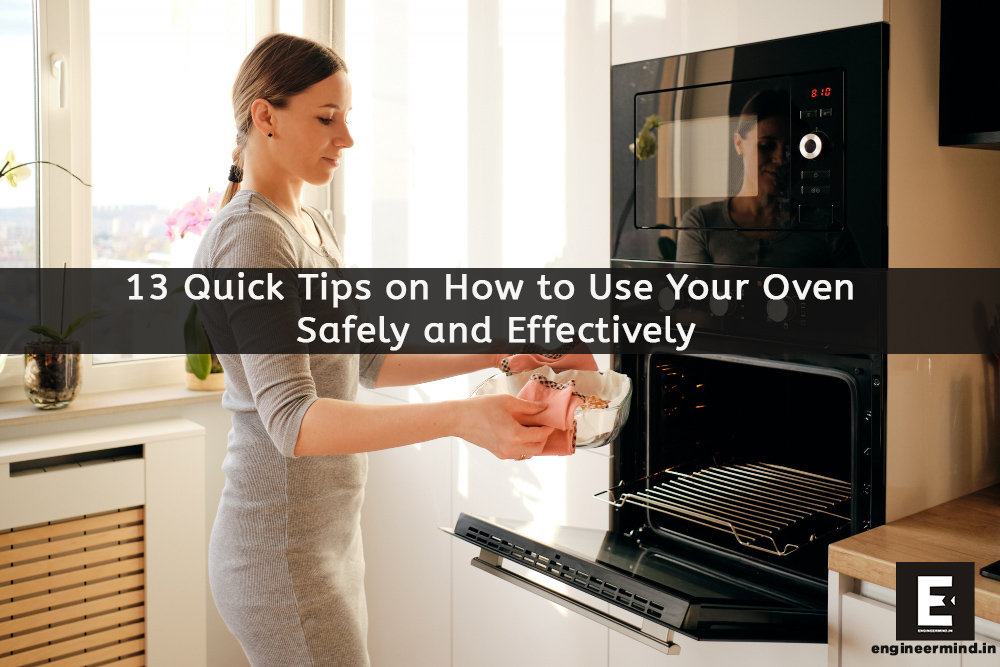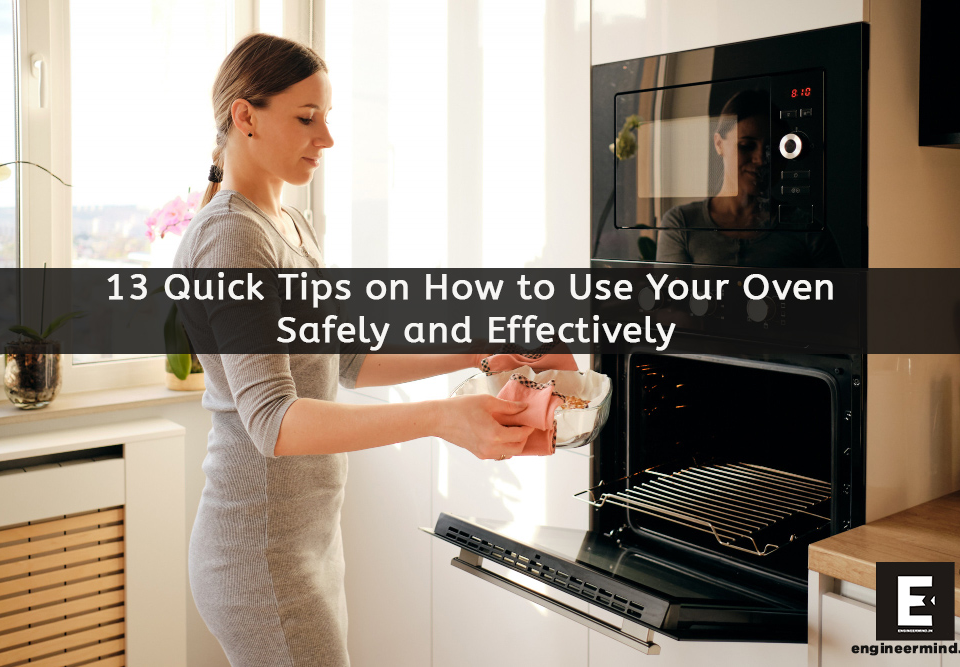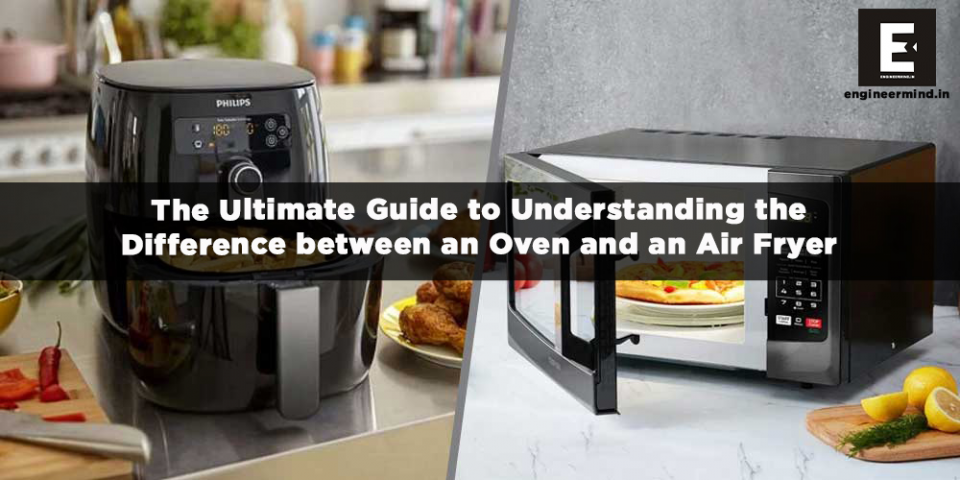Using an oven efficiently and safely is essential for every home cook. Whether you are a novice or an experienced chef, understanding the proper techniques and precautions will not only protect you from accidents but also ensure delicious and well-cooked meals. In this article, we will provide you with valuable tips on how to use oven safely. By following these guidelines, you can confidently prepare your favourite recipes without any worries.

Electric ovens were invented in 1896, but they weren’t commonly utilized until the late 1920s when electricity became more feasible. Stainless steel, double wall ovens, electric ranges, and microwave ovens advance this technology. Microwaves were invented in the 1940s when Raytheon engineer Percy Spencer discovered microwave beam heating during radar research. Our kitchens now provide dozens of cooking alternatives. Thus, cooking dinner over an open fire is unnecessary.
Table of Contents
How does the oven work?
An oven works by using heat to cook food. There are several different types of ovens, but most modern ovens use electricity or gas as a power source.
A traditional oven has a heating element, usually made of metal, at the bottom or the back of the oven. The heating element is powered by electricity or gas, and it generates heat. This heat is then distributed throughout the oven by convection (hot air moving around the oven) or by radiation (heat being absorbed by the walls of the oven).
An oven also has a thermostat which is used to control the temperature inside the oven. The thermostat senses the temperature inside the oven and adjusts the heating element accordingly to maintain the desired temperature.
When you put food in the oven, the heat cooks it by causing chemical reactions, such as the Maillard reaction which makes the food brown and gives it a desirable taste.
Some ovens also come with a fan that helps circulate the hot air inside the oven, which make the heat distribute more evenly and cooks food faster.
Tips on how to use oven
Can oven racks go in the dishwasher?
In most cases, the answer is that oven racks are safe to clean in the dishwasher. The majority of oven racks are constructed out of metals like chrome or steel, which are resistant to high temperatures, and detergents that are utilized in a dishwasher. It is essential, however, to examine the instructions provided by the manufacturer for your particular oven racks to determine whether or not they can be cleaned in a dishwasher.
It is vital to verify the instructions before putting oven racks in the dishwasher because some of them are covered with a non-stick coating that might not be able to withstand the intense heat and detergents that are found in a dishwasher.
It is also essential to keep in mind that if the racks in your oven are really dirty or have a large amount of food that has been baked, it is possible that they will need to be cleaned by hand before being placed in the dishwasher.
When will the oven not heat up?
There are a number of potential explanations in the event that your oven does not heat up. Some common causes include:
- A fuse that has blown or a circuit breaker that has tripped: Check to check if any fuses have burned out or if the circuit breaker has been tripped.
- An issue with the oven’s thermostat is responsible for controlling the temperature within the oven. It is possible that the oven will not heat up if it is not functioning properly.
- An issue with the oven’s heating element is the heating element is responsible for producing heat for the oven. It is possible that the oven will not heat up if it has been broken or if it is not functioning properly.
- A control board that is not working properly: The control board is responsible for managing the functions of the oven, including the heating element. It is possible that the oven will not heat up if it is not functioning properly.
- An obstruction in the oven vent: The oven vent is what permits the circulation of hot air within the oven. It is possible that the oven will not heat up correctly if it is obstructed in any way.
- Problems with the power supply: Check to see that the oven is correctly plugged in and that the outlet in question is operational.
It is recommended to call a professional to diagnose and repair the oven if you are unable to figure out what the issue is or if it is not something that can be easily fixed.
Which oven rack to use?
When you use your oven, the location of the oven rack in the oven might have an impact on the final product. Here are some general recommendations for using oven racks:
- The bottom rack is where you will find the oven’s most intense heat. Utilize this rack for baking items like pizzas, casseroles, and cookies that require a significant amount of browning.
- The majority of dishes should be placed on the middle rack, as this is the most convenient location. Utilize this rack for items like cakes, bread, and roasts that require uniform cooking, as they will turn out better this way.
- The top rack is the location in the oven that maintains the lowest temperature. Make sure to make use of this rack while preparing foods like custards and quiches that require low and slow cooking.
- The broiler is the top heating element that is used to brown the top of food and may be found in most modern kitchens. Make delicious meals with this, such as grilled steaks, toasted sandwiches, or melted cheese.
Because the positioning of the oven rack may be different depending on the type of oven you have, it is always a good idea to consult the instructions provided by the manufacturer of your oven for more specific information. It is important to note that these are just general guidelines and that the placement of the oven rack may vary.
Where oven is used?
An oven is a popular piece of equipment seen in kitchens. Ovens are used for a variety of purposes, including baking, roasting, and heating meals. Ovens are versatile cooking appliances that may be used to prepare a wide range of foods, from meats and casseroles to bread and pastries. The majority of the time, you can find them in private homes’ cooking areas, but you can also find them at commercial establishments like restaurants and bakeries.
In addition to being found in laboratories and manufacturing companies, ovens are also commonplace in industrial kitchens and other types of settings. For instance, ovens can be found in laboratories for the purpose of drying out samples, in manufacturing plants for the purpose of heat-treating materials, and in industrial kitchens for the purpose of performing large-scale cooking operations.
There are also speciality ovens that are used for certain purposes, such as toasting bread, drying flowers, drying pottery, or manufacturing glass. Examples of some of the things that may be done in these ovens include:
In a nutshell, ovens have many potential applications, including those in the domestic, commercial, and industrial spheres, as well as those in the artistic and scientific communities.
What oven temp to keep food warm?
It is recommended that the temperature in the oven be kept between 150 and 200 degrees Fahrenheit in order to keep meals warm (65-93 degrees Celsius). This temperature is low enough to prevent the meal from cooking anymore but high enough to maintain it at a temperature that is safe for serving.
It is essential to keep in mind that different kinds of food will have varied temperatures that are recommended for holding them. For instance, the United States Food and Drug Administration (FDA) suggests that perishable foods be stored at temperatures of at least 140 degrees Fahrenheit (60 degrees Celsius).
It is essential to adequately cover the food to prevent it from losing its moisture and to not leave it in the oven for an excessively long period of time, since this might cause the meal to become dry.
Before serving, it is essential to check the temperature of the meal with a food thermometer to ensure that it has reached the appropriate temperature for consumption. This will ensure that the food is not contaminated.
Utilizing an oven thermometer to verify the temperature inside the oven is another recommended method for ensuring that the temperature is correct and stable during the cooking process.
Will oven cleaner remove paint?
Oven cleaner is a powerful chemical agent that is meant to remove thick, baked-on oil and food residue from oven surfaces. It does this by breaking down the grease and food residue into smaller pieces. Oven cleanser may be good at removing paint, but using it for this purpose is not suggested because it may cause damage to the surface or cause a chemical reaction to the paint. Both of these outcomes are undesirable.
If it comes into touch with a person’s skin or eyes, oven cleaner, which is composed of harsh chemicals such as sodium hydroxide, can cause harm to the skin and eyes. If the paint to be removed is oil-based, using it to remove the paint may cause the surface beneath the paint to become discolored or etched, and it may also cause toxic fumes to be released.
When you need to remove paint from a surface, the most effective method is to make use of a paint stripper that has been developed specifically for the kind of paint that you are attempting to remove. In general, these products are gentler and more effective than others at removing paint without causing any damage to the surface beneath the paint.
When working with chemicals, it is usually a good idea to follow the manufacturer’s directions very carefully and to protect oneself by wearing protective gear such as gloves, goggles, and other gear like that.
Are oven bags safe?
Oven cooking bags are composed of food-safe polymers or nylons that are heatproof up to or above the normal temperatures used in ovens. The highest temperature that may be reached in an oven is 450 degrees Fahrenheit. The vast majority of oven bags that can be purchased in stores have been certified as FDA-compliant, which indicates that they do not contain BPA or any other potentially harmful chemicals.
It is not recommended to use oven roasting bags in electric roasters or toaster ovens as they were made to be used in traditional ovens only. Using oven bags permits the meats to roast in their own juices, which results in dishes that are both tasty and moist. Using oven bags improves the colour and texture of vegetables, making them appear more vibrant and crisp.
When oven smoking?
Smoking ovens can be caused by several factors. Possible causes:
- Food residue: When the oven is turned on, food residue or spills in the bottom can smoke. If spills or food remains are not cleaned after usage, this can happen.
- Overheating: A hot oven can smoke food. If the oven thermostat fails to regulate temperature, this can happen also.
- Smoke from oven vent obstruction: Food spills or residue can obstruct vents.
- Oil or fat in the oven might smoke when heated. A dirty baking sheet or non-stick surface can cause this.
- Oven malfunction: Smoke from the heating element or other elements may indicate an oven fault.
- Cleaning the oven should fix food residue and spills-related smoke. Overheating or a broken thermostat requires skilled oven repair. If the oven is smoking, turn it off and call a professional.
Smoking ovens can cause fires and release toxic chemicals, so fix them immediately.
Conclusion
Using an oven safely requires understanding its features, following the manufacturer’s guidelines, and implementing proper precautions. By familiarizing yourself with the oven, choosing suitable cookware, and practising careful handling, you can minimize risks and enjoy the cooking process. Remember to prioritize safety, maintain cleanliness, and be aware of potential hazards. With these tips, you can confidently and safely create delicious meals for yourself and your loved ones.
FAQs
1. Can I open the oven door while cooking?
It’s generally advisable to avoid opening the oven door frequently while cooking, as it can cause temperature fluctuations and affect the cooking process. However, if necessary, open the door briefly and minimize the time to prevent heat loss.
2. Is it safe to leave the oven unattended?
Leaving the oven unattended for extended periods is not recommended. It’s essential to stay near the oven while cooking to monitor the progress and address any potential issues promptly.
3. How often should I clean my oven?
Regular cleaning is essential to maintain a safe and efficient oven. The frequency of cleaning depends on usage, but it’s recommended to clean spills and residues as soon as possible and perform a thorough cleaning at least once every few months.
4. What should I do if I smell gas while using the oven?
If you smell gas while using the oven, immediately turn off the appliance, open windows for ventilation, and evacuate the area. Contact the gas company or emergency services to address the issue and ensure safety.
5. Can I use aluminum foil in the oven?
Yes, you can use aluminum foil in the oven, but it’s important to use it correctly. Avoid covering the entire oven rack with foil, as it can restrict proper airflow. Instead, use foil to line baking sheets or cover specific areas to prevent excessive browning or drippings.







